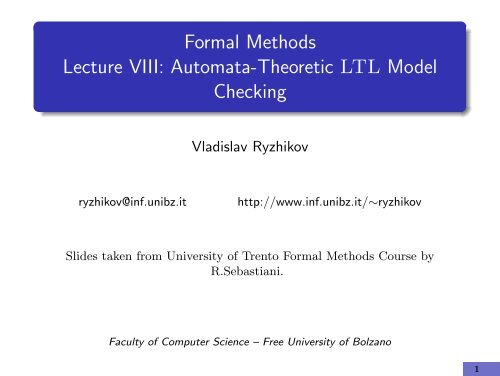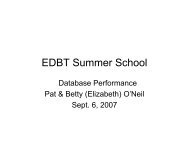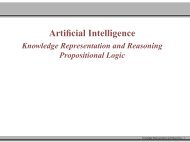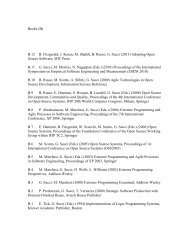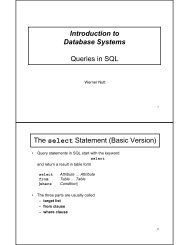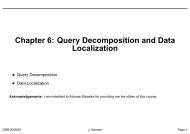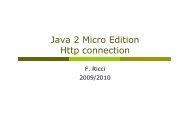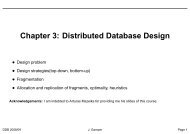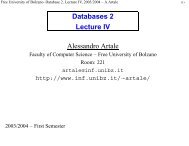Automata-Theoretic LTL Model Checking - Faculty of Computer ...
Automata-Theoretic LTL Model Checking - Faculty of Computer ...
Automata-Theoretic LTL Model Checking - Faculty of Computer ...
Create successful ePaper yourself
Turn your PDF publications into a flip-book with our unique Google optimized e-Paper software.
Formal Methods<br />
Lecture VIII: <strong>Automata</strong>-<strong>Theoretic</strong> <strong>LTL</strong> <strong>Model</strong><br />
<strong>Checking</strong><br />
Vladislav Ryzhikov<br />
ryzhikov@inf.unibz.it<br />
http://www.inf.unibz.it/∼ryzhikov<br />
Slides taken from University <strong>of</strong> Trento Formal Methods Course by<br />
R.Sebastiani.<br />
<strong>Faculty</strong> <strong>of</strong> <strong>Computer</strong> Science – Free University <strong>of</strong> Bolzano<br />
1
Summary<br />
unibz.it<br />
The Problem<br />
<strong>Automata</strong> on Finite Words<br />
<strong>Automata</strong> on Infinite Words<br />
From Kripke Structures to Büchi <strong>Automata</strong><br />
From <strong>LTL</strong> Formulas to Büchi <strong>Automata</strong><br />
<strong>Automata</strong>-<strong>Theoretic</strong> <strong>LTL</strong> <strong>Model</strong> <strong>Checking</strong><br />
2
The Problem<br />
unibz.it<br />
Given a Kripke structure M and an <strong>LTL</strong> specification ψ, does<br />
M satisfy ψ?<br />
M |= ψ<br />
3
<strong>Automata</strong>-<strong>Theoretic</strong> <strong>LTL</strong> <strong>Model</strong> <strong>Checking</strong><br />
unibz.it<br />
M |= ψ<br />
(<strong>LTL</strong>)<br />
⇐⇒ M |= ✷ p ψ (on all paths ψ)<br />
⇐⇒ L(M) ⊆ L(ψ)<br />
⇐⇒ L(M) ∩ L(¬ψ) = {}<br />
⇐⇒ L(A M ) ∩ L(A ¬ψ ) = {}<br />
⇐⇒ L(A M × A ¬ψ ) = {}<br />
A M is a Büchi Automaton equivalent to M (which<br />
represents all and only the executions <strong>of</strong> M)<br />
A ¬ψ is a Büchi Automaton which represents all and<br />
only the paths that satisfy ¬ψ (do not satisfy ψ)<br />
=⇒ A M × A ¬ψ represents all and only the paths<br />
appearing in M and not in ψ.<br />
4
<strong>Automata</strong>-<strong>Theoretic</strong> <strong>LTL</strong> <strong>Model</strong> <strong>Checking</strong><br />
unibz.it<br />
Four steps:<br />
1 Compute A M<br />
2 Compute A ϕ<br />
3 Compute the product A M × A ϕ<br />
4 Check the emptiness <strong>of</strong> L(A M × A ϕ )<br />
5
Summary<br />
unibz.it<br />
The Problem<br />
<strong>Automata</strong> on Finite Words<br />
<strong>Automata</strong> on Infinite Words<br />
From Kripke Structures to Büchi <strong>Automata</strong><br />
From <strong>LTL</strong> Formulas to Büchi <strong>Automata</strong><br />
<strong>Automata</strong>-<strong>Theoretic</strong> <strong>LTL</strong> <strong>Model</strong> <strong>Checking</strong><br />
6
Finite Word Languages<br />
unibz.it<br />
Example<br />
An alphabet Σ is a collection <strong>of</strong> symbols (letters).<br />
E.g. Σ = {a, b}.<br />
A finite word is a finite sequence <strong>of</strong> letters. (E.g. aabb.)<br />
The set <strong>of</strong> all finite words is denoted by Σ ∗ .<br />
A language U is a set <strong>of</strong> words, i.e. U ⊆ Σ ∗ .<br />
Words over Σ = {a, b} with equal number <strong>of</strong> a’s and b’s. (E.g.<br />
aabb or abba.)<br />
Language recognition problem. Determine whether a word belongs<br />
to a language.<br />
<strong>Automata</strong> are computational devices able to solve language<br />
recognition problems.<br />
7
Finite State <strong>Automata</strong><br />
unibz.it<br />
Basic model <strong>of</strong> computational systems with finite memory.<br />
Widely applicable<br />
Embedded System Controllers.<br />
Languages: Ester-el, Lustre, Verilog.<br />
Synchronous Circuits.<br />
Regular Expression Pattern Matching<br />
Grep, Lex, Emacs.<br />
Protocols<br />
Network Protocols<br />
Architecture: Bus, Cache Coherence, Telephony,...<br />
8
Notation<br />
unibz.it<br />
a, b ∈ Σ finite alphabet.<br />
u, v, w ∈ Σ ∗ finite words.<br />
λ empty word.<br />
u.v catenation.<br />
u i = u.u. .u repeated i-times.<br />
U, V ⊆ Σ ∗ finite word languages.<br />
9
FSA Definition<br />
unibz.it<br />
Definition (Nondeterministic Finite State Automaton (NFA))<br />
NFA is (Q, Σ, δ, I , F ) where<br />
Q finite set <strong>of</strong> states<br />
I ⊆ Q set <strong>of</strong> initial states<br />
F ⊆ Q set <strong>of</strong> final states<br />
→⊆ Q × Σ × Q transition relation (edges)<br />
We use q<br />
a −→ q ′ to denote (q, a, q ′ ) ∈ δ.<br />
Definition (Deterministic Finite State Automaton (DFA))<br />
DFA is NFA with<br />
δ : Q × Σ → Q a total function<br />
Single initial state I = {q 0 }<br />
10
Regular Languages<br />
unibz.it<br />
A run <strong>of</strong> NFA A on u = a 0 , a 1 , . . . , a n−1 is a finite sequence<br />
a<br />
<strong>of</strong> states q 0 , q 1 , . . . , q n s.t. q 0 ∈ I and q<br />
i<br />
i −→ qi+1 for<br />
0 ≤ i < n.<br />
An accepting run is one where the last state q n ∈ F .<br />
The language accepted by A<br />
L(A) = {u ∈ Σ ∗ | A has an accepting run on u}<br />
The languages accepted by a NFA are called regular<br />
languages.<br />
11
Finite State <strong>Automata</strong><br />
unibz.it<br />
Let Σ = {a, b}<br />
Example<br />
DFA A 1 recognizes words which do not end in b<br />
a b b<br />
Example<br />
s 1<br />
s 2<br />
a<br />
NFA A 2 recognizes words which end in b<br />
a,b<br />
b<br />
s 1<br />
s 2<br />
b<br />
12
Determinisation<br />
unibz.it<br />
Theorem (Determinisation)<br />
Given a NFA A we can construct a DFA A ′ s.t. L(A) = L(A ′ ).<br />
Size |A ′ | = 2 O(|A|) .<br />
13
Determinisation [cont.]<br />
unibz.it<br />
Example<br />
NFA A 2 : Words which end in b.<br />
a,b<br />
b<br />
s 1<br />
s<br />
b 2<br />
A 2 can be determinised into the automaton DA 2 below.<br />
a b b<br />
s 1<br />
s 1<br />
,s 2<br />
a<br />
Study Topic There are NFA’s <strong>of</strong> size n for which the size <strong>of</strong> the<br />
minimum sized DFA must have size O(2 n ).<br />
14
Closure Properties<br />
unibz.it<br />
Theorem (Boolean Closure)<br />
Given NFA A 1 , A 2 over Σ we can construct NFA A over Σ s.t.<br />
L(A) = L(A 1 ) (Complement). |A| = 2 O(|A1|) .<br />
L(A) = L(A 1 ) ∪ L(A 2 ) (Union). |A| = |A 1 | + |A 2 |.<br />
L(A) = L(A 1 ) ∩ L(A 2 ) (Intersection). |A| = |A 1 | · |A 2 |.<br />
15
Complementation <strong>of</strong> a NFA<br />
unibz.it<br />
A NFA A = (Q, Σ, δ, I , F ) is complemented by:<br />
determinizing it into a DFA A ′ = (Q ′ , Σ ′ , δ ′ , I ′ , F ′ )<br />
complementing it: A ′ = (Q ′ , Σ ′ , δ ′ , I ′ , F ′ )<br />
|A ′ | = |A ′ | = 2 O(|A 1|)<br />
16
Union <strong>of</strong> two NFA’s<br />
unibz.it<br />
Two NFA’s A 1 = (Q 1 , Σ 1 , δ 1 , I 1 , F 1 ), A 2 = (Q 2 , Σ 2 , δ 2 , I 2 , F 2 ),<br />
A = A 1 ∪ A 2 = (Q, Σ, δ, I , F ) is defined as follows<br />
Q := Q 1 ∪ Q 2 , I := I 1 ∪ I 2 , F := F 1 ∪ F 2<br />
A is an automaton which just runs nondeterministically either<br />
A 1 or A 2<br />
L(A) = L(A 1 ) ∪ L(A 2 )<br />
|A| = |A 1 | + |A 2 |<br />
17
Synchronous Product Construction<br />
unibz.it<br />
Let A 1 = (Q 1 , Σ, δ 1 , I 1 , F 1 ) and A 2 = (Q 2 , Σ, δ 2 , I 2 , F 2 ). Then,<br />
A 1 × A 2 = (Q, Σ, δ, I , F ) where<br />
Q = Q 1 × Q 2 . I = I 1 × I 2 .<br />
F = F 1 × F 2 .<br />
< p, q > −→< a p ′ , q ′ > iff p<br />
a −→ p ′ and q<br />
a −→ q ′ .<br />
Theorem<br />
L(A 1 × A 2 ) = L(A 1 ) ∩ L(A 2 )<br />
18
Synchronous Product Construction (Cont.)<br />
unibz.it<br />
Example<br />
a<br />
b<br />
s 0<br />
t 0<br />
b b b a a<br />
b<br />
a t 1<br />
s 1<br />
a<br />
A 1 recognizes words with A 2 recognizes words with<br />
an even number <strong>of</strong> b a number <strong>of</strong> a mod 3 = 0<br />
t 2<br />
The Product Automaton A 1 × A 2 with F = {s 0 , t 0 }.<br />
b<br />
s s t 0<br />
t 0<br />
1 0<br />
b<br />
a a a a<br />
a<br />
s0 t<br />
s 0<br />
t a<br />
1<br />
t 1<br />
2<br />
s1 t s 1 2<br />
b<br />
b<br />
b<br />
b<br />
19
Decision Problems<br />
unibz.it<br />
Theorem (Emptiness)<br />
Given a NFA A we can decide whether L(A) = ∅.<br />
Method: Forward/Backward Reachability <strong>of</strong> acceptance states in<br />
Automaton graph. Complexity is O(|Q| + |δ|).<br />
Theorem (Language Containment)<br />
Given NFA A 1 and A 2 we can decide whether L(A 1 ) ⊆ L(A 2 ).<br />
Method: L(A 1 ) ⊆ L(A 2 ) iff L(A 1 ) ∩ L(A 2 ) = ∅. Complexity is<br />
O(|A 1 | · 2 |A 2| ).<br />
20
Regular Expressions<br />
unibz.it<br />
Syntax: ∅ | ɛ | a | reg 1 .reg 2 | reg 1 + reg 2 | reg ∗ .<br />
Every regular expression reg denotes a language L(reg).<br />
Example<br />
(a ∗ .(b + bb).a ∗ . The words with either 1 b or 2 consecutive b’s<br />
Theorem<br />
For every regular expression reg we can construct a language<br />
equivalent NFA <strong>of</strong> size O(|reg|).<br />
Theorem<br />
For every DFA A we can construct a language equivalent regular<br />
expression reg(A).<br />
21
Infinite Word Languages<br />
unibz.it<br />
<strong>Model</strong>ing infinite computations <strong>of</strong> reactive systems.<br />
Example<br />
An ω-word α over Σ is infinite sequence<br />
a 0 , a 1 , a 2 . . ..<br />
Formally, α : N ↦→ Σ.<br />
The set <strong>of</strong> all infinite words is denoted by Σ ω .<br />
A ω-language L is collection <strong>of</strong> ω-words, i.e. L ⊆ Σ ω .<br />
All words over {a, b} with infinitely many a’s.<br />
Notation:<br />
omega words α, β, γ ∈ Σ ω .<br />
omega-languages L, L 1 ⊆ Σ ω<br />
For u ∈ Σ + , let u ω = u.u.u . . .<br />
22
Summary<br />
unibz.it<br />
The Problem<br />
<strong>Automata</strong> on Finite Words<br />
<strong>Automata</strong> on Infinite Words<br />
From Kripke Structures to Büchi <strong>Automata</strong><br />
From <strong>LTL</strong> Formulas to Büchi <strong>Automata</strong><br />
<strong>Automata</strong>-<strong>Theoretic</strong> <strong>LTL</strong> <strong>Model</strong> <strong>Checking</strong><br />
23
Omega-<strong>Automata</strong><br />
unibz.it<br />
We consider automaton runs over infinite words.<br />
Example<br />
a,b<br />
s 1<br />
s 2<br />
b<br />
b<br />
Let α = aabbbb . . .. There are several possible runs.<br />
Run ρ 1 = s 1 , s 1 , s 1 , s 1 , s 2 , s 2 . . .<br />
Run ρ 2 = s 1 , s 1 , s 1 , s 1 , s 1 , s 1 . . .<br />
Acceptance Conditions: Büchi, (Muller, Rabin, Street).<br />
Acceptance is based on states occurring infinitely<br />
<strong>of</strong>ten<br />
Notation: Let ρ ∈ Q ω . Then,<br />
Inf (ρ) = {s ∈ Q | ∃ ∞ i ∈ N. ρ(i) = s}.<br />
24
Büchi <strong>Automata</strong><br />
unibz.it<br />
Definition (Nondeterministic Büchi Automaton)<br />
A = (Q, Σ, δ, I , F ), where F ⊆ Q is the set <strong>of</strong> accepting states.<br />
A run ρ <strong>of</strong> A on omega word α is an infinite sequence<br />
a<br />
ρ = q o , q 1 , q 2 , . . . s.t. q 0 ∈ I and q<br />
i<br />
i −→ qi+1 for 0 ≤ i.<br />
The run ρ is accepting if<br />
Inf (ρ) ∩ F ≠ ∅.<br />
The language accepted by A<br />
L(A) = {α ∈ Σ ω | A has an accepting run on α}<br />
25
Büchi Automaton: Example<br />
unibz.it<br />
Let Σ = {a, b}.<br />
Example<br />
Deterministic Büchi Automaton (DBA) A 1<br />
a b b<br />
s 1<br />
s 2<br />
With F = {s 1 } the automaton recognizes words with<br />
infinitely many a’s.<br />
a<br />
26
Büchi Automaton: Example (2)<br />
unibz.it<br />
Example<br />
NBA A 2<br />
a,b<br />
b<br />
s 1<br />
s 2<br />
b<br />
With F = {s 2 }, automaton A 2 recognizes words with finitely<br />
many a.<br />
Thus, L(A 2 ) = L(A 1 ).<br />
27
Deterministic vs. Nondeterministic Büchi <strong>Automata</strong><br />
unibz.it<br />
Theorem<br />
DBA’s are strictly less powerful than NBA’s.<br />
28
Closure Properties<br />
unibz.it<br />
Theorem (union, intersection)<br />
For the NBA’s A 1 , A 2 we can construct<br />
– the NBA A s.t. L(A) = L(A 1 ) ∪ L(A 2 ). |A| = |A 1 | + |A 2 |<br />
– the NBA A s.t. L(A) = L(A 1 ) ∩ L(A 2 ). |A| = |A 1 | · |A 2 | · 2.<br />
29
Union <strong>of</strong> two NBA’s<br />
unibz.it<br />
Two NBA’s A 1 = (Q 1 , Σ 1 , δ 1 , I 1 , F 1 ), A 2 = (Q 2 , Σ 2 , δ 2 , I 2 , F 2 ),<br />
A = A 1 ∪ A 2 = (Q, Σ, δ, I , F ) is defined as follows<br />
Q := Q 1 ∪ Q 2 , I := I 1 ∪ I 2 , F := F 1 ∪ F 2<br />
A is an automaton which just runs nondeterministically either<br />
A 1 or A 2<br />
L(A) = L(A 1 ) ∪ L(A 2 )<br />
|A| = |A 1 | + |A 2 |<br />
(same construction as with ordinary automata)<br />
30
Synchronous Product <strong>of</strong> NBA’s<br />
unibz.it<br />
Let A 1 = (Q 1 , Σ, δ 1 , I 1 , F 1 ) and A 2 = (Q 2 , Σ, δ 2 , I 2 , F 2 ).<br />
Then, A 1 × A 2 = (Q, Σ, δ, I , F ), where<br />
Q = Q 1 × Q 2 × {1, 2}.<br />
I = I 1 × I 2 × {1}.<br />
F = F 1 × Q 2 × {1}.<br />
< p, q, 1 > −→< a p ′ , q ′ , 1 > iff p −→ a p ′ and q −→ a q ′ and p ∉ F 1 .<br />
< p, q, 1 > −→< a p ′ , q ′ , 2 > iff p −→ a p ′ and q −→ a q ′ and p ∈ F 1 .<br />
< p, q, 2 > −→< a p ′ , q ′ , 2 > iff p −→ a p ′ and q −→ a q ′ and q ∉ F 2 .<br />
< p, q, 2 > −→< a p ′ , q ′ , 1 > iff p −→ a p ′ and q −→ a q ′ and q ∈ F 2 .<br />
Theorem<br />
L(A 1 × A 2 ) = L(A 1 ) ∩ L(A 2 )<br />
31
Product <strong>of</strong> NBA’s: Intuition<br />
unibz.it<br />
The automaton remembers two tracks, one for each source<br />
NBA, and it points to one <strong>of</strong> the two tracks<br />
As soon as it goes through an accepting state <strong>of</strong> the current<br />
track, it switches to the other track<br />
thus to visit infinitely <strong>of</strong>ten a state in F (i.e., F 1 ), it must visit<br />
infinitely <strong>of</strong>ten some state also in F 2<br />
Important subcase: If F 2 = Q 2 , then<br />
Q = Q 1 × Q 2 .<br />
I = I 1 × I 2 .<br />
F = F 1 × Q 2 .<br />
32
Product <strong>of</strong> NBA’s: Example<br />
a<br />
b<br />
unibz.it<br />
s 0<br />
t 0<br />
b b b a a<br />
b<br />
a t 1<br />
s 1<br />
a<br />
t 2<br />
s s t 0<br />
t 0 1<br />
1 0 1<br />
b<br />
b<br />
a a<br />
s0 t s 0<br />
t a<br />
1 1 s1 1 s 1<br />
t 1 1<br />
21<br />
t 2<br />
1 to 2<br />
2 to 1<br />
a<br />
a<br />
b<br />
s 0<br />
t 0 2<br />
a<br />
b<br />
b<br />
s 1<br />
t 0<br />
a<br />
a<br />
a<br />
a<br />
s0 t s 0<br />
t a<br />
1<br />
t 1<br />
22<br />
2 s1 t s 1 2<br />
2 2<br />
b<br />
b<br />
b<br />
b<br />
b<br />
b<br />
b TRACK 1<br />
a<br />
TRACK 2<br />
2<br />
33
Closure Properties (2)<br />
unibz.it<br />
Theorem (Complementation)<br />
For the NBA A 1 we can construct an NBA A 2 such that<br />
L(A 2 ) = L(A 1 ).<br />
Corollary<br />
|A 2 | = O(2 |A 1|·log(|A 1 |) )<br />
Method:<br />
1 Convert a Büchi automaton into a Non-Deterministic Rabin<br />
automaton.<br />
2 Determinize and Complement the Rabin automaton<br />
3 Convert the Rabin automaton into a Büchi automaton<br />
34
Generalized Büchi Automaton<br />
unibz.it<br />
A Generalized Büchi Automaton is A := (Q, Σ, δ, I , FT ) where<br />
FT = < F 1 , F 2 , . . . , F k > with F i ⊆ Q.<br />
A run ρ <strong>of</strong> A is accepting if Inf (ρ) ∩ F i ≠ ∅ for each 1 ≤ i ≤ k.<br />
Theorem<br />
For every Generalized Büchi Automaton (A, FT ) we can construct<br />
a language equivalent Büchi Automaton (A ′ , G ′ ).<br />
Pro<strong>of</strong>.<br />
(Construction) Let Q ′ = Q × {1, . . . , k}.<br />
Automaton remains in i phase till it visits a state in F i . Then, it<br />
moves to i + 1 mode. After phase k it moves to phase 1.<br />
Size: |A ′ | ≤ |A| · k.<br />
35
Omega Regular Expressions<br />
unibz.it<br />
A language is called ω-regular if it has the form ∪ n i=1<br />
where U i , V i are regular languages.<br />
Theorem<br />
A language L is ω-regular iff it is NBA-recognizable.<br />
U i.(V i ) ω<br />
36
Decision Problem<br />
unibz.it<br />
Theorem (Emptiness)<br />
For a NBA A, it is decidable whether L(A) = ∅.<br />
Method<br />
Find the maximal strongly connected components (MSCC) in<br />
the graph <strong>of</strong> A (disregarding the edge labels).<br />
A MSCC C is called non-trivial if C ∩ F ≠ ∅ and C has at<br />
least one edge.<br />
Find all nodes from which there is a path to a non-trivial<br />
SCC. Call the set <strong>of</strong> these nodes as N.<br />
L(A) = ∅ iff N ∩ I = ∅.<br />
Time Complexity: O(|Q| + |δ|).<br />
37
Summary<br />
unibz.it<br />
The Problem<br />
<strong>Automata</strong> on Finite Words<br />
<strong>Automata</strong> on Infinite Words<br />
From Kripke Structures to Büchi <strong>Automata</strong><br />
From <strong>LTL</strong> Formulas to Büchi <strong>Automata</strong><br />
<strong>Automata</strong>-<strong>Theoretic</strong> <strong>LTL</strong> <strong>Model</strong> <strong>Checking</strong><br />
38
Computing a NBA from a Kripke Structure<br />
unibz.it<br />
Transforming a K.S. M = 〈S, S 0 , R, L, AP〉 into an NBA<br />
A M = 〈Q, Σ, δ, I , F 〉 s.t.:<br />
States: Q := S ∪ {init}, init being a new initial state<br />
Alphabet: Σ := 2 AP<br />
Initial State: I := {init}<br />
Accepting States: F := Q = S ∪ {init}<br />
Transitions:<br />
δ : q −→ a<br />
q ′ iff (q, q ′ ) ∈ R and L(q ′ ) = a<br />
a<br />
init −→ q iff q ∈ S 0 and L(q) = a<br />
L(A M ) = L(M)<br />
|A M | = |M| + 1<br />
39
Computing a NBA from a Kripke Structure: Example<br />
unibz.it<br />
Substantially, add one initial state, move labels from states to<br />
incoming edges, set all states as accepting states<br />
40
Computing a NBA from a Fair Kripke Structure<br />
unibz.it<br />
Transforming a fair K.S. M = 〈S, S 0 , R, L, AP, FT 〉,<br />
FT = {F 1 , ..., F n }, into an NBA A M = 〈Q, Σ, δ, I , F 〉 s.t.:<br />
States: Q := S ∪ {init}, init being a new initial state<br />
Alphabet: Σ := 2 AP<br />
Initial State: I := {init}<br />
Accepting States: F := FT<br />
Transitions:<br />
δ : q −→ a<br />
q ′ iff (a, a ′ ) ∈ R and L(q ′ ) = a<br />
a<br />
init −→ q iff q ∈ S 0 and L(q ′ ) = a<br />
L(A M ) = L(M)<br />
|A M | = |M| + 1<br />
41
Summary<br />
unibz.it<br />
The Problem<br />
<strong>Automata</strong> on Finite Words<br />
<strong>Automata</strong> on Infinite Words<br />
From Kripke Structures to Büchi <strong>Automata</strong><br />
From <strong>LTL</strong> Formulas to Büchi <strong>Automata</strong><br />
<strong>Automata</strong>-<strong>Theoretic</strong> <strong>LTL</strong> <strong>Model</strong> <strong>Checking</strong><br />
42
Paths as ω-words<br />
unibz.it<br />
NB We consider <strong>LTL</strong> formulas with operators ¬, ∨, ○, U only.<br />
Let ϕ be an <strong>LTL</strong> formula.<br />
Example<br />
Var(ϕ) denotes the set <strong>of</strong> free variables <strong>of</strong> ϕ.<br />
E.g. Var(p ∧ (¬q U q)) = {p, q}.<br />
Let Σ := 2 Var(ϕ) .<br />
⇒ a model for ϕ is an ω-word α = a 0 , a 1 , . . . in Σ ω .<br />
We can define α, i |= ϕ. Also, α |= ϕ iff α, 0 |= ϕ.<br />
A model <strong>of</strong> p ∧ (¬q U q) is the ω-word<br />
{p}, {}, {q}, {p, q} ω .<br />
N.B.: correspondence between ω-words and paths in Kripke<br />
structures:<br />
α, i |= ϕ ⇐⇒ π, s i |= ϕ, α, 0 |= ϕ ⇐⇒ π, s 0 |= ϕ<br />
43
<strong>Automata</strong> for <strong>LTL</strong> model checking<br />
unibz.it<br />
Let Mod(ϕ) denote the set <strong>of</strong> models <strong>of</strong> ϕ.<br />
Theorem<br />
For any <strong>LTL</strong> formula ϕ, the set Mod(ϕ) is omega-regular.<br />
Pro<strong>of</strong>.<br />
Construct a NBA A ϕ such that Mod(ϕ) = L(A ϕ ).<br />
44
Closures<br />
unibz.it<br />
Closure Given ϕ ∈ <strong>LTL</strong>, let CL ′ (ϕ) be the smallest set s.t.<br />
ϕ ∈ CL ′ (ϕ).<br />
If ¬ϕ 1 ∈ CL ′ (ϕ) then ϕ 1 ∈ CL ′ (ϕ).<br />
If ϕ 1 ∨ ϕ 2 ∈ CL ′ (ϕ) then ϕ 1 , ϕ 2 ∈ CL ′ (ϕ).<br />
If ○ϕ 1 ∈ CL ′ (ϕ) then ϕ 1 ∈ CL ′ (ϕ).<br />
If (ϕ 1 U ϕ 2 ) ∈ CL ′ (ϕ) then ϕ 1 , ϕ 2 ∈ CL ′ (ϕ) and<br />
○(ϕ 1 U ϕ 2 ) ∈ CL ′ (ϕ)<br />
CL(ϕ) := {ϕ 1 , ¬ϕ 1 | ϕ 1 ∈ CL ′ (ϕ)} (we identify ¬¬ϕ 1 with ϕ 1 .)<br />
N.B.: |CL(ϕ)| = O(|ϕ|).<br />
45
Atoms<br />
unibz.it<br />
An Atom is a maximal consistent subset <strong>of</strong> CL(ϕ).<br />
Definition<br />
A set A ⊆ CL(ϕ) is called an atom if<br />
For all ϕ 1 ∈ CL(ϕ), we have ϕ 1 ∈ A iff ¬ϕ 1 /∈ A.<br />
For all ϕ 1 ∨ ϕ 2 ∈ CL(ϕ), we have ϕ 1 ∨ ϕ 2 ∈ A iff ϕ 1 ∈ A or<br />
ϕ 2 ∈ A (or both).<br />
For all (ϕ 1 U ϕ 2 ) ∈ CL(ϕ), we have (ϕ 1 U ϕ 2 ) ∈ A iff ϕ 2 ∈ A<br />
or (ϕ 1 ∈ A and ○(ϕ 1 U ϕ 2 ) ∈ A).<br />
Essentially, an atom is a consistent truth assignment to the<br />
elementary subformulas <strong>of</strong> ϕ<br />
We call Atoms(ϕ) the set <strong>of</strong> all atoms <strong>of</strong> ϕ.<br />
46
Definition <strong>of</strong> A ϕ<br />
unibz.it<br />
For an <strong>LTL</strong> formula ϕ, we construct a Generalized NBA<br />
A ϕ = (Q, Σ, δ, Q 0 , FT ) as follows:<br />
Σ = 2 vars(ϕ)<br />
Q = Atoms(ϕ), the set <strong>of</strong> atoms.<br />
δ is s.t., for q, q ′ ∈ Atoms(ϕ) and a ∈ Σ, q −→ a q ′ holds in δ<br />
iff<br />
q ∩ Var(ϕ) = a,<br />
for all ○ϕ 1 ∈ CL(ϕ), we have ○ϕ 1 ∈ q iff ϕ 1 ∈ q ′ .<br />
Q 0<br />
= {q ∈ Atoms(ϕ) | ϕ ∈ q}.<br />
FT = (F 1 , F 2 , . . . , F k ) where, for all (ψ i U ϕ i ) occurring<br />
positively in ϕ,<br />
F i = {q ∈ Atoms(ϕ) | (ψ i U ϕ i ) /∈ q or ϕ i ∈ q}.<br />
47
Definition <strong>of</strong> A ϕ [cont.]<br />
unibz.it<br />
Theorem<br />
Let α = a 0 , a 1 , . . . ∈ Σ ω . Then, α |= ϕ iff α ∈ L(A ϕ ).<br />
Size: |A ϕ | = O(2 |ϕ| ).<br />
48
Example<br />
Let φ = p U q, then<br />
CL ′ = {p, q, p U q, ○(p U q)<br />
CL = {p, q, p U q, ○(p U q), ¬p, ¬q, ¬p U q, ¬○(p U q)<br />
Atoms = {1 :{p, q, p U q, ○(p U q)},<br />
2 :{¬p, q, p U q, ○(p U q)},<br />
3 :{p, ¬q, p U q, ○(p U q)},<br />
4 :{¬p, ¬q, p U q, ¬○(p U q)},<br />
5 :{¬p, ¬q, ¬p U q, ○(p U q)},<br />
6 :{p, q, p U q, ¬○(p U q)},<br />
7 :{p, ¬q, ¬p U q, ¬○(p U q)},<br />
8 :{¬p, ¬q, ¬p U q, ¬○(p U q)}}<br />
unibz.it<br />
Q 0 = {s | (p U q) ∈ s} = {1, 2, 3, 4, 6}<br />
σ ∋{φ p , φ q , φ pUq , ○(p U q)} {φp,φq}<br />
−→ {ψ p , ψ q , p U q, ψ ○(pUq) },<br />
{φ p , φ q , φ pUq , ¬○(p U q)} {φp,φq}<br />
−→ {ψ p , ψ q , ¬p U q, ψ ○(pUq) }<br />
F 1 = {s | (p U q) ∉ s or q ∈ s} = {1, 2, 4, 5, 6, 7, 8}<br />
49
Example (cont.)<br />
unibz.it<br />
50
Role <strong>of</strong> Acceptance Conditions<br />
unibz.it<br />
Example<br />
σ alone does not guarantee that p U q is “fulfilled”<br />
State 3 with {p, ¬q, p U q, ○(p U q)}<br />
Although p U q holds in state 3, the path which loops forever<br />
in state 3 does not satisfy φ = p U q as q never holds in that<br />
path<br />
That’s why 3 is not an accepting state in F 1 . But any path<br />
going infinitely through a state in F 1 “fulfills” p U q<br />
51
Summary<br />
unibz.it<br />
The Problem<br />
<strong>Automata</strong> on Finite Words<br />
<strong>Automata</strong> on Infinite Words<br />
From Kripke Structures to Büchi <strong>Automata</strong><br />
From <strong>LTL</strong> Formulas to Büchi <strong>Automata</strong><br />
<strong>Automata</strong>-<strong>Theoretic</strong> <strong>LTL</strong> <strong>Model</strong> <strong>Checking</strong><br />
52
<strong>Automata</strong>-<strong>Theoretic</strong> <strong>LTL</strong> <strong>Model</strong> <strong>Checking</strong><br />
unibz.it<br />
Four steps:<br />
1 Compute A M<br />
2 Compute A ϕ<br />
3 Compute the product A M × A ϕ<br />
4 Check the emptiness <strong>of</strong> L(A M × A ϕ )<br />
53
<strong>Automata</strong>-<strong>Theoretic</strong> <strong>LTL</strong> <strong>Model</strong> <strong>Checking</strong>: complexity<br />
unibz.it<br />
Four steps:<br />
1 Compute A M : |A M | = O(|M|)<br />
2 Compute A ϕ<br />
3 Compute the product A M × A ϕ<br />
4 Check the emptiness <strong>of</strong> L(A M × A ϕ )<br />
54
<strong>Automata</strong>-<strong>Theoretic</strong> <strong>LTL</strong> <strong>Model</strong> <strong>Checking</strong>: complexity [cont.]<br />
Four steps:<br />
1 Compute A M : |A M | = O(|M|)<br />
2 Compute A ϕ : |A ϕ | = O(2 |ϕ| )<br />
3 Compute the product A M × A ϕ<br />
4 Check the emptiness <strong>of</strong> L(A M × A ϕ )<br />
55
<strong>Automata</strong>-<strong>Theoretic</strong> <strong>LTL</strong> <strong>Model</strong> <strong>Checking</strong>: complexity [cont.]<br />
Four steps:<br />
1 Compute A M : |A M | = O(|M|)<br />
2 Compute A ϕ : |A ϕ | = O(2 |ϕ| )<br />
3 Compute the product A M × A ϕ :<br />
|A M × A ϕ | = |A M | · |A ϕ | = O(|M| · 2 |ϕ| )<br />
4 Check the emptiness <strong>of</strong> L(A M × A ϕ )<br />
56
<strong>Automata</strong>-<strong>Theoretic</strong> <strong>LTL</strong> <strong>Model</strong> <strong>Checking</strong>: complexity [cont.]<br />
Four steps:<br />
1 Compute A M : |A M | = O(|M|)<br />
2 Compute A ϕ : |A ϕ | = O(2 |ϕ| )<br />
3 Compute the product A M × A ϕ :<br />
|A M × A ϕ | = |A M | · |A ϕ | = O(|M| · 2 |ϕ| )<br />
4 Check the emptiness <strong>of</strong> L(A M × A ϕ ):<br />
O(|A M × A ϕ |) = O(|M| · 2 |ϕ| )<br />
⇒ the complexity <strong>of</strong> <strong>LTL</strong> M.C. grows linearly wrt. the size <strong>of</strong> the<br />
model M and exponentially wrt. the size <strong>of</strong> the property ϕ<br />
57
Final Remarks<br />
unibz.it<br />
Büchi automata are in general more expressive than <strong>LTL</strong>!<br />
Some tools (e.g., Spin, ObjectGEODE) allow specifications to<br />
be expressed directly as NBA’s<br />
for every <strong>LTL</strong> formula, there are many possible equivalent<br />
NBA’s<br />
lots <strong>of</strong> research for finding “the best” conversion algorithm<br />
performing the product and checking emptiness very relevant<br />
lots <strong>of</strong> techniques developed (e.g., partial order reduction)<br />
lots on ongoing research<br />
58


